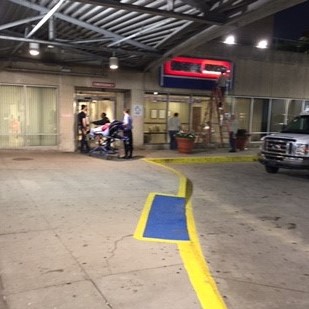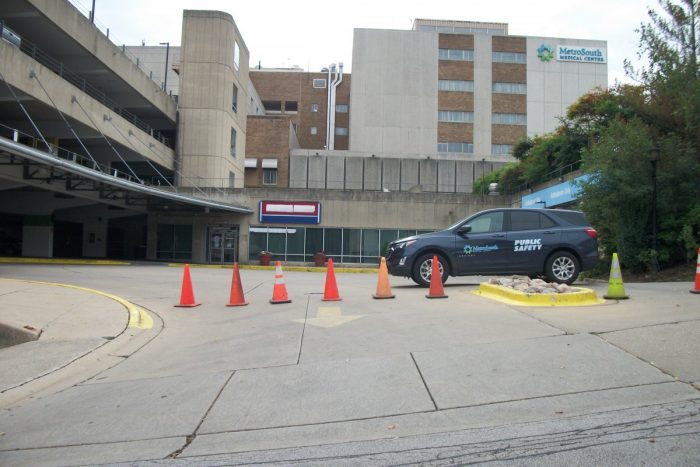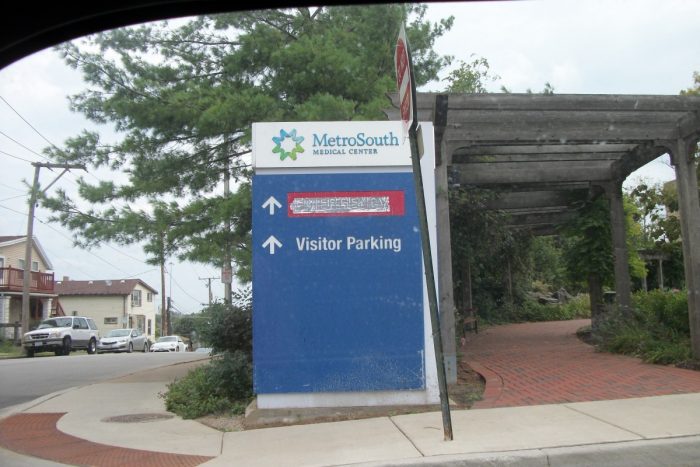A few years ago, I went to the Oak Forest hospital for a free TB test as
a requirement to work in home healthcare. Upon telling the officer at the gate
why I was there, I was directed where to park and to enter a door on the north
side. Once inside, there was an extremely long corridor and NOBODY was in
sight. The corridor was like two blocks long.
As I quietly walked along, I passed one nurse’s station after another
on the left and empty stretchers and wheelchairs on the right. There was
complete silence. (If these walls could talk.) The eeriest part were the clocks
on the wall. Every clock at each nurse’s station was stopped at a different
time. 11 minutes after 2:00 … 40 minutes after 6:00 … It would never be known
if the clocks stopped in the day or night. Each clock likely continued ticking
after the employees and patients moved out and were pronounced dead in their
own time.
Finally, I heard the ding of an elevator. I thought of ducking behind a
partitioned wall but just stood there looking at the elevator. A lady in
burgundy scrubs stepped out and was startled to see me. I told her this place
would be a great scene for a horror movie. She agreed and said it was very spooky
working there and directed me where to go. It was such a shame that a place
that once served a purpose and gleamed with life, now sat empty. Such is the
threat with MetroSouth.
The Daily Southtown reported last
month that MetroSouth operators said “that years of decreasing patient volumes,
increasing market saturation, reduced insurance reimbursement and ongoing
operational losses” contributed to the hospital’s decision to likely close
unless finding a buyer. The concern here is that officials have known for a
couple years of the peril and have spoken to “nearly 40 healthcare
organizations but none were willing to operate MetroSouth as a full-service
community hospital (hold that thought).” By the time the public gets notice,
everyone is in a scrambling state of mayday.
The latter two cited reasons I
understand firsthand from working in healthcare. First, regarding “reduced
insurance reimbursement,” Medicare and Medicaid allow patients to get care
upfront (services and drugs), but it takes a long time for the service provider
to get reimbursed from the government. Meanwhile, the service provider has to
pay monthly expenses and it’s like trying to fill a bucket with a hole in it. The
government may also only reimburse a lesser amount than the actual cost of the
service.
Second, “ongoing operational
losses,” is something that is more likely in a hospital because of the 24/7
operation. It’s harder to run a tight ship with hundreds of employees. Years
ago, I worked at MetroSouth for a short period of time and found some practices
disturbing. We’re talking thousands of dollars wasted on a monthly basis. These
practices would obviously catch up with them. I was not there long enough to
request help. Proper training and all three shifts working closer together
could have helped reduce this loss.
Let’s think about why there are “decreased
patients.” Nowadays, there is a lot of emphasis on preventative care,
especially with all the cancer screenings, etc. Before drug stores offered flu
shots, I had to make an appointment with a doctor. Advances in equipment have
allowed many outpatient services. Urgent care facilities have lightened the
load of emergency rooms. Maintenance medicine has kept people out of hospitals
and increased lifespan. Has all this contributed to hospitals possibly becoming
obsolete? Instead of being a double-edged sword, maybe we should go with the
natural flow. We may need to consider repurposing the hospital instead of just closing
it, which would leave an all-or-nothing result.
Apparently, there is a problem
with MetroSouth having 314 beds that they can’t fill. Well, do we want an
epidemic just to fill the beds with sick people? Why can’t the number of
hospital beds be downsized to accommodate the actual need? Instead of
eliminating a full-service hospital, what does the hospital have that is still serving
a purpose? The Daily Southtown reported that MetroSouth’s outpatient center is
being diligently pursued.
Since patients are spending less
time hospitalized and living longer, where will all of these aging folks live? A
hospital offers a skeletal framework that can accommodate BOTH an independent
living facility, as well as an assisted living one. Assisted living facilities need
a medical staff (that is already there). Seniors are vulnerable to broken
bones, joint replacements, etc., and often need physical therapy. A
rehabilitation facility is already there. Ambulances make frequent trips to
senior-living facilities, and again, medical staff is already there.
MetroSouth also has a built-in
cafeteria, a fitness center, an outdoor garden/refuge space. Why can’t some
sections be consolidated for certain purposes while renting out space for the
growing senior population? According to Crowe LLP Healthcare, “If
hospitals want to remain vital to their
communities, they must change. Repurposing is always expensive. The question
they have to ask themselves is can they afford not to (Modern Healthcare, 2015).”
Remember, 40 healthcare organizations were unwilling to operate
MetroSouth as a full-service community hospital. What about a partial-service
one combined with something else? A training or educational facility is also a
possibility especially with Moraine Valley nearby.
Hospitals
closing is not just here in Illinois. In October, 2017, the Harvard
Business Review reported that since the beginning of 2016, the financial
performance of hospitals and health systems in the United States has
significantly worsened. “The root cause is twofold: a mismatch between
organizations’ strategies and actual market demand, and a lack of operational
discipline.” Again, I’m thinking of the preventable waste that I witnessed.
Blue
Island obviously stands to lose a lot here, but what about the surrounding
communities? Calumet Park Mayor Ronald Denson said he was surprised by the lack
of notice or engagement prior to the announcement, given area residents’
reliance on MetroSouth for a variety of health services and the critical role
of MetroSouth in Calumet Park’s emergency management plans. “Although all impacts
haven’t been defined, given the sudden notice, the closure would certainly
affect fire and police department operations and require revisions of emergency
management plans for area municipalities.”
Mayor
Denson further stated that he has actively engaged with municipalities in the
area that will be impacted by the closure, as well as elected officials
representing the area, since the notice was received. “In particular, I
have been in close contact with leadership for the municipalities served by the
Cal-Comm 911 Center to discuss shared concerns and assess impacts of this
sudden development.”
The Village of Calumet Park is hosting a press conference, Tuesday, July 23, 11:00 a.m., at the Village Hall (12409 S. Throop St.) for residents and officials of all communities affected by the abrupt closure of MetroSouth. All are encouraged to attend.
The above article was submitted to the FORUM on July 15, 2019, and published for their July issue.




